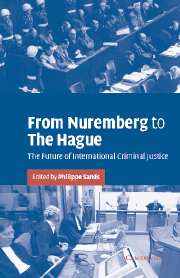Book contents
- Frontmatter
- Contents
- Notes on the contributors
- Preface
- 1 The Nuremberg trials: international law in the making
- 2 Issues of complexity, complicity and complementarity: from the Nuremberg trials to the dawn of the new International Criminal Court
- 3 After Pinochet: the role of national courts
- 4 The drafting of the Rome Statute
- 5 Prospects and issues for the International Criminal Court: lessons from Yugoslavia and Rwanda
1 - The Nuremberg trials: international law in the making
Published online by Cambridge University Press: 18 July 2009
- Frontmatter
- Contents
- Notes on the contributors
- Preface
- 1 The Nuremberg trials: international law in the making
- 2 Issues of complexity, complicity and complementarity: from the Nuremberg trials to the dawn of the new International Criminal Court
- 3 After Pinochet: the role of national courts
- 4 The drafting of the Rome Statute
- 5 Prospects and issues for the International Criminal Court: lessons from Yugoslavia and Rwanda
Summary
In October 1945, as he awaited trial as a major war criminal, Robert Ley wrote a long and cogent repudiation of the right of the recently victorious Allies to try German leaders for war crimes. The Indictment served on Ley, and others, on 19 October 1945 claimed that ‘[a]ll the defendants … formulated and executed a common plan or conspiracy to commit Crimes against Humanity as defined’. Ley continued: ‘Where is this plan? Show it to me. Where is the protocol or the fact that only those here accused met and said a single word about what the indictment refers to so monstrously? Not a thing of it is true.’ A few days later, Ley committed suicide in his cell rather than face the shame of a public trial.
The unease about the legal basis of the trial was not confined to those who were to stand before it. Legal opinion in Britain and the United States was divided on the right of the victors to bring German leaders before a court for war crimes. The Nuremberg Military Tribunal was, as Ley realised, an experiment, almost an improvisation. For the first time the leaders of a major state were to be arraigned by the international community for conspiring to perpetrate, or causing to be perpetrated, a whole series of crimes against peace and against humanity. For all its evident drawbacks, the trial proved to be the foundation of what has now become a permanent feature of modern international justice.
- Type
- Chapter
- Information
- From Nuremberg to The HagueThe Future of International Criminal Justice, pp. 1 - 29Publisher: Cambridge University PressPrint publication year: 2003
- 10
- Cited by



